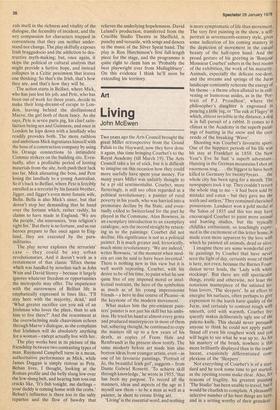Art
Living
John McEwen
Two years ago the Arts Council brought the great Millet retrospective from the Grand Palais to the Hayward; now they have done it again, this time bringing Courbet's to the Royal Academy (till March 19). The Arts Council take a lot of stick, but it is difficult to imagine on this occasion how they could more usefully have spent your money. For many years Millet was unfairly thought to be a pi old sentimentalist. Courbet, more flatteringly, is still too often regarded as a political revolutionary; a painter of rural poverty in his youth, who was harried into a premature decline by the State, and eventually exiled to Switzerland for the part he played in the Commune. Alan Bowness, in an exemplary introduction to an exemplary catalogue, sets the record straight by returning us to the paintings: Courbet did not decline. His significance is not as a political painter. It is much greater and, historically, much more revolutionary. 'We are indeed,' writes Bowness, 'at the moment when modern art can be said to have been invented.' There is nothing new in this view but it is well worth repeating. Courbet, with his desire to be of his time, to paint what he saw quite free of any imposed moral or intellectual restraint, the hero of the symbolists as much as of his young impressionist friends — a hero in due course of Picasso —is the keystone of the modern movement.
What makes him the pre-eminent painters' painter is not just his skill but his ambition. He tried his hand at almost every genre and produced masterpieces in most of them but, sobering thought, he continued to copy the masters till up to a few years of his death, as copies of Frans Hals and Rembrandt in the present show testify. The same modesty before art made him also borrow ideas from younger artists, even — as one of his favourite paintings, 'Portrait of Jo, the beautiful Irish girl', suggests — from Dante Gabriel Rossetti. 'To achieve skill through knowledge,' he wrote in 1955, 'that has been my purpose. To record all the manners, ideas and aspects of the age as I myself saw them — to be a man as well as a painter, in short to create living art.
'Living' is the essential word, and nothing
is more symptomatic of life than movement. The very first painting in the show, a selfportrait in seventeenth-century style, gives some indication of his coming mastery in the depiction of movement in the casual beauty of the half-open hand. And the proud gesture of his greeting in 'Bonjour Monsieur Courbet' ushers in the best rooms of the exhibition, the work of his maturity. Animals, especially the delicate roe-deer, and the streams and springs of the Juras landscape constantly reiterate the energy of his theme — a theme often alluted to in enlivening or humorous asides, as in the 'Portrait of P.J. Proudhon', where the philosopher's daughter is engrossed in pouring a little jug, or 'The oak at Flagey' in which, almost invisible in the distance, a dog is in full pursuit of a rabbit. It comes to a climax at the Academy in the superb paintings of hunting in the snow and the crescendo of the breaking 'Wave'.
Shooting was Courbet's favourite sport. One of the happiest periods of his life was his stay at Frankfurt in 1858. On New Year's Eve he had 'a superb adventure. Hunting in the German mountains I shot an enormous,stag, . . . the biggest to have been killed in Germany for twenty9years . . . the whole city has been agog for a month. The newspapers took it up. They couldn't return the whole stag to me — it had been sold by mistake and eaten — but they gave me the teeth and antlers.' They remained cherished possessions. Landseer won a gold medal at the Salon of 1855 and this too may have encouraged Courbet to paint more animal and hunting studies, but the typicallY childlike enthusiasm, so touchingly expressed in the excitement of this letter home, is made even more apparent by the love with which he painted all animals, dead or alive.
I imagine there are some wonderful erotic paintings by Courbet that have never seen the light of day, certainly none of their is here, not even, because the Barnes Foundation never lends, the 'Lady with white stockings'. But there are still spectacular things, erotic and otherwise, not least the notorious masterpiece of the satiated lesbian lovers, 'The sleepers'. In an effort ta energise his surfaces, often perhaps to give expression to the harsh karst quality of the Juras, and certainly to contrast rough with smooth, cold with warmth, Courbet frequently makes deliberately ugly use of the palette-knife. This should never persuade anyone to think he could not apply paint Stand off even his roughest work and you will begin to see what he was up to. As for his mastery of the brush, nowhere is this more brilliantly displayed than in the translucent, exquisitely differentiated complexions of the 'Sleepers'.
Not everything of Courbet's is of a standard and he took some time to get started, as the opening rooms make clear. Also, for reasons of fragility, his greatest paintin$ 'The Studio' has been unable to travel, but it would be churlish to complain. A pleasantly selective number of his best things are here, and in a setting worthy of their grandeur.


































 Previous page
Previous page